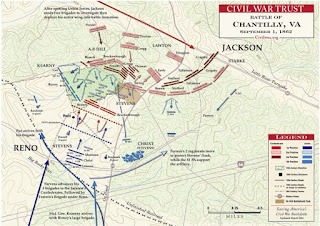 Over the years, I
have had a chance to visit every battlefield where the Branch-Lane fought, walking
the ground where they fought, save one: the battle of Ox Hill, or Chantilly. On
a recent visit to Washington, D. C., I remedied that omission. I have checked
that battlefield off my list and can say I've trod everywhere they fought, and
marched, and camped.
Over the years, I
have had a chance to visit every battlefield where the Branch-Lane fought, walking
the ground where they fought, save one: the battle of Ox Hill, or Chantilly. On
a recent visit to Washington, D. C., I remedied that omission. I have checked
that battlefield off my list and can say I've trod everywhere they fought, and
marched, and camped.
So why have I not
visited the Ox Hill battlefield? Well, there is really nothing left. We'll come
back to that.
The battle of Ox
Hill came at the end of the Second Manassas Campaign, and the beginning of the
Maryland Campaign. Stonewall Jackson had swung around the flank and into the
rear of the Federal army under John Pope. After capturing the Manassas Depot of
August 27, Jackson fell back into a defensive position and waited for the
Federals to attack. They did just that on August 29, and it was a hard fight
for Jackson. Lee, with Longstreet's corps, came up later that day, and on August
30, attacked Pope's flank in the "largest, simultaneous mass assault of
the war." The left flank of the Federals was crushed, and they started
falling back towards Washington City. The battle of Second Manassas produced an
estimated 22,000 casualties.
 |
| Monuments to the two Union generals killed. |
Even though they had borne the brunt of the fighting,
Jackson 's corps was sent to follow up the attack. He hoped to cut off the
Federal retreat and destroy Pope's army in detail. According to the National
Park Service, by "Making a wide
flank march, Jackson hoped to cut off the Union retreat from Bull Run. On
September 1, beyond Chantilly Plantation on the Little River Turnpike near Ox
Hill, Jackson sent his divisions against two Union divisions under Kearny and
Stevens. Confederate attacks were stopped by fierce fighting during a severe
thunderstorm. Union generals Stevens and Kearny were both killed. Recognizing
that his army was still in danger at Fairfax Courthouse, Maj. Gen. Pope ordered
the retreat to continue to Washington. With Pope no longer a threat, Lee turned
his army west and north to invade Maryland, initiating the Maryland Campaign
and the battles of South Mountain and Antietam."
 |
| American Battlefield Trust map of the Ox Hill battlefield. |
Branch's brigade was involved early on in the fighting. They
were ordered to deploy (with Brockenbrough's brigade) about five that afternoon
(September 1), and moved off to their right. Rain soon began to fall in
torrents. Capt. James S. Harris, 7th North Carolina State Troops, wrote that
the two brigades "scaled a high fence on the right of the road, advanced
through an open field and body of woods to a fence near the foot of a hill
where the battle was immediately joined. In front there was a meadow, and
beyond that, a large field of standing corn which rendered the exact location
of the enemy's line uncertain, until by the smoke of the battle and growing
darkness, it could be outlined by the flashes of his guns.... Finding his
ammunition was nearly out, Gen. Branch applied to Gen. Jackson for help,
stating that his 'guns were wet,' to which Jackson curtly replied, 'tell Gen.
Branch I have no troops to send him, the enemy's guns are wet, also, and if
pressed he must hold his position with the bayonet.'" Of course, Branch
did hold, and other troops came up. But the darkness and rain, after two hours
of fighting, brought the battle of Ox Hill to an end. The Federals were to
escape into the defensives of Washington. Lee, knowing he did not have enough
men to lay siege or assault the Federal capital, and not really being able to
supply his men so exposed, moved off toward Maryland.
 |
| Current image of the battlefield. |
So, why have I never visited the Ox Hill battlefield?
Probably because only 4.8 acres (out of 300) are preserved as a park. The rest
of the battle was lost to development in the 1980s. And it was a fight to have
those 4.8 acres secured from development. It was that second fight at Ox Hill that led
to the founding of the Association for the Preservation of Civil War Sites.
This group later merged with the American Battlefield Protection Foundation to
become the Civil War Preservation Trust, then renamed the Civil War Trust, and
more recently, the American Battlefield Trust. Over 50,000 acres of battlefield
land has been preserved. I've been a member for probably 20 years, and I am a
charter member of the American Battlefield Trust.
The position where Branch's brigade fought is in a condo
development, probably along Sleepy Lake Drive. There is really not anything to
see. But we were staying in Chantilly, and it was only a couple of miles away,
on a late Saturday afternoon, and worth a visit to me so I could cross it off
the list.
In preserving 50,000 acres of battlefield land, the American
Battlefield Trust is doing an amazing thing. I don't always agree with them
(Danville was not the last Confederate capital), but I am proud to be a member.
Let me encourage you to check them out (click here).